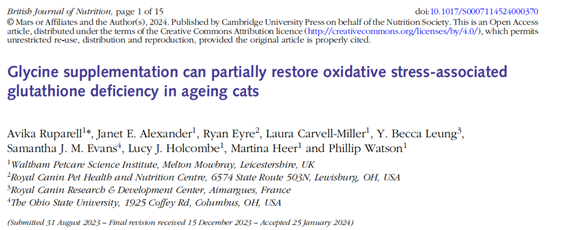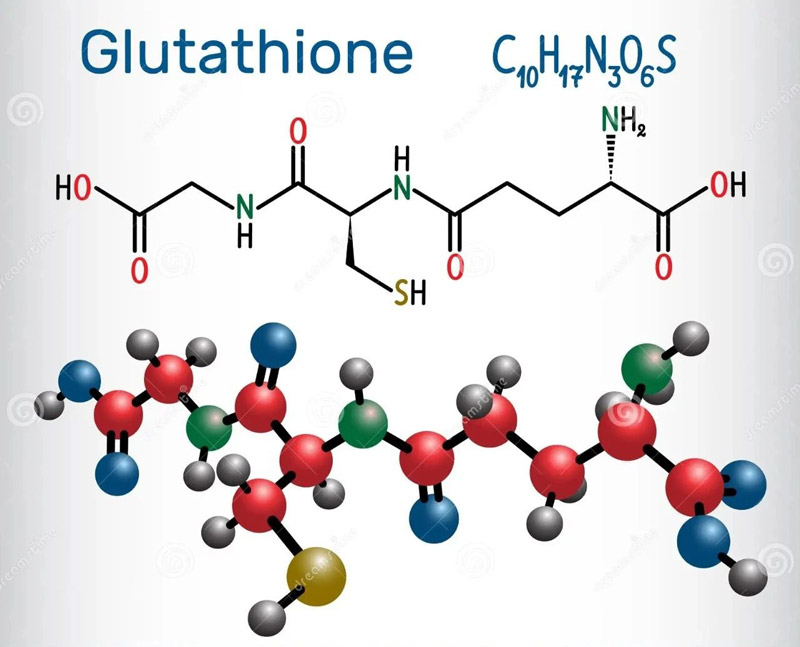Glycine supplementation partially restores oxidative stress-related glutathione deficiency in aging cats
Research background
The root cause of senescence is cellular senescence.
According to the theory of oxidative stress and free radicals, aging is caused by cell oxidation reaction to produce free radicals, and the accumulation of free radicals will cause damage to cells and tissues, thus promoting aging.
Anti-oxidation and anti-free radical have become the key to anti-aging.
An important marker of aging is an increase in oxidative stress. In some species, intracellular levels of glutathione, the main antioxidant in mammals, decline with age.
The most abundant antioxidant in mammalian cells is glutathione (GSH), a tripeptide composed of glutamic acid, cysteine (CYS), and glycine (GLY).
Glutathione (GSH) can resist oxidation, participate in immune regulation, coordinate and enhance cell work. Studies have found that oxidative stress and abnormal GSH metabolism are associated with a variety of feline diseases. Glutathione supplier
Glutathione Investigation process and result
1. Glutathione Research methods
1.1 Effects of aging on glutathione
The first study consisted of 32 healthy adult cats (22 females, 10 males) divided into young and old groups, with an average of 16 cats per group. Young group (mean age: 2.9 years); Elderly group (mean age: 9.7 years)
3 ml blood samples were taken from the medial saphenous vein twice at 1 month intervals to compare (whole blood)WB and red blood cell total GSH, reduced glutathione (GSH) and aortic tissue oxidized glutathione (GSSG) and free plasma cysteine (CYS), glycine (GLY) and methionine concentrations
1.2 Compare glycine supplementation at different levels
To determine the level of GLY required to increase the concentration of GLY in the blood, 52 elderly cats (33 females, 19 males) with an average age of 12.1 years participated in a 16-week study that included dietary rotations over eight 2-week sessions. Experimental dry food supplemented with 0.5%, 1.5% or 6.0% free GLY.
1.3 Effects of glycine supplementation on glutathione and oxidative stress indexes
Forty-four older cats, with an average age of 11.7 years,
participated in the study for 16 weeks, including a four-week adaptation phase and a 12-week testing phase. During the 4-week adaptation phase, the cats were given control dry food.
During the testing phase, the elderly cats were randomly divided into two groups of 22 cats, one group continued to eat the control dry food,
and the other group immediately switched to the test dry food supplemented with 1.5% free GLY.
2. Explore the process in detail
2.1 Effects of aging on glutathione
Total erythrocyte glutathione was significantly lower in older cats (> 9 years) than in younger (< 3 years) age groups. The mean total glutathione of red blood cells was 672.3μM in elderly cats and 946.6μM in young adults. Compared with the young group, the total glutathione content of WB in the elderly group was also significantly lower.
2.2 Comparison of glycine supplementation at different levels
In plasma, free GLY levels were significantly different between the final and baseline time points at dietary supplementation of 1.5% and 6.0% free GLY levels (all P < 0.001).
There was no difference in plasma free GLY when the content of free GLY was 0-5%. At dietary free GLY supplementation of 0.5%, 1-5%, and 6-0%, there were significant differences in red cell free GLY levels between the final and baseline time points (all P < 0-001).
These data provide the basis for the selection of 1-5% GLY dietary supplement levels in subsequent feeding studies.
2.3 Effects of glycine supplementation on glutathione and oxidative stress indexes
Dietary intervention had an effect on erythrocyte glutathione. At week 4, it was found that the total glutathione concentration was significantly higher in the GLY supplement group than in the control group.
At week 4, significantly higher GSH levels observed in red blood cells supplemented with 1.5% free GLY.
No further statistically significant differences in RBC total glutathione or GSH found at the sampling sites in the remaining phases of the trial.
2.4 Oxidative damage index
The study found that dietary GLY supplementation affected 8-OHdG and some urine F2-IsoPs, which are markers of oxidative damage.
Compared with the control group, the test cats had significantly lower concentrations of 8-OHDG at week 8,
but the difference between groups was not significant at the beginning and end of the dietary supplementation phase.
Among the four F2-IsoPs quantified, comparisons between study groups found statistically significant differences in PGF2α,
with lower levels in the supplemental GLY group compared to the control group.
A few parameters in the biochemical group were statistically significant between the different diet groups. At weeks 4 and 8, cholesterol levels in the test group were significantly lower than in the control group.




Research summary
Glutathione is an antioxidant that is important for maintaining oxidative defense, which in turn determines cell survival.
This series of studies aimed to determine whether glutathione affected by aging in cats, and whether supplementation with the glutathione precursor GLY alters circulating GLY and glutathione levels and markers of oxidative stress in healthy elderly cats over a 12-week dietary supplement period.
The results of the study showed that these oxidative stress markers reduced after the addition of free GLY to the diet of elderly cats. In this study, dietary supplementation with GLY significantly reduced F2-IsoPs.
The 8-OHdG in plasma is the best measure of the mutagenic consequences of oxidative stress. These results suggest that dietary supplementation with GLY can alter markers of oxidative stress in older cats,
and this appears to depend on an increase in erythrocyte glutathione.
The results of feeding studies suggest that adding 1-5% of free GLY (a precursor of glutathione) to the diet may be a viable way to alleviate glutathione reduction in older cats.
In the article it has been able to confirm that older cats have significantly lower levels of GSH (the most abundant antioxidant) in their bodies compared to young adult cats.
Providing dry food supplemented with 1-5% free GLY for 12 weeks in elderly cats significantly increased red blood cell total glutathione and GSH levels,
but this limited to early in the supplementation phase.
The findings suggest that dietary supplementation of free GLY at tested concentrations can partially mitigate the age-related decline in red cell GSH in cats,
but further studies needed to investigate the mechanism of action of GLY and the effects of supplementation with other GSH precursors.
reference
Glycine supplementation can partially restore oxidative stress-associated glutathione deficiency in ageing cats | British Journal of Nutrition | Cambridge Core



